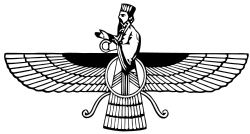
Back مثرا Arabic মিথ্রা Bengali/Bangla Mitra (mitologia) Catalan Mithra Czech Mithra German Μίθρας Greek Mitra (dios persa) Spanish Mithra Estonian مهر (ایزد ایرانی) Persian Mitra French
| Mithra | |
|---|---|
God of Covenant and Light | |
 Relief from Taq-e Bostan in Kermanshah Iran. In this relief, Ardashir II is in the middle and to his right is Ahura Mazda and to the left of the king, the god Mithra, with beams of light like the sun emanating from his head in all directions, and he is standing on a sacred lotus flower.[1][2][3] | |
| Avestan | Miθra 𐬨𐬌𐬚𐬭𐬀 |
| Affiliation | The Thirty-Three Deities, Guardians of the Days of the Month, The Twelve Deities |
| Abode | Mount Hara |
| Symbol | Sunlight, light, Lion, Cypress tree |
| Sacred flower | Scarlet Rose |
| Attributes | God of the Covenant, God of Light and Brightness, God of War, God of Truth, Guardian of the Covenant, Judge of Deeds on the Final Day |
| Day | 16th of each month in the Iranian calendar، Sunday of each week |
| Mount | Chariot |
| Gender | Male |
| Temples | Mithraeum |
| Festivals | Mehregan, Yalda Night (Birth of Mithra) |
| Associated deities | Verethragna, Rashnu, Sraosha |
| Equivalents | |
| Greek | Mithras |
| Roman | Mitras |
| Indian Equivalent | Mitra |
| Part of a series on |
| Zoroastrianism |
|---|
 |
|
|
Mithra (Avestan: 𐬨𐬌𐬚𐬭𐬀 Miθra; Old Persian: 𐎷𐎰𐎼 Miθraʰ) is an ancient Iranian deity (yazata) of covenants, light, oaths, justice, the Sun,[4] contracts, and friendship.[5] In addition to being the divinity of contracts, Mithra is also a judicial figure, an all-seeing protector of Truth (Asha), and the guardian of cattle, the harvest, and the Waters.
The Romans attributed their Mithraic mysteries to Zoroastrian Persian sources relating to Mithra. Since the early 1970s, the dominant scholarship has noted dissimilarities between the Persian and Roman traditions, making it, at most, the result of Roman perceptions of Zoroastrian ideas.[6]
- ^ طاق بستان، نقشها و سازهایش | صفحه ۲
- ^ تمدن ایران ساسانی، ص ۳۲۲
- ^ کریستن سن، ص ۱۶۶
- ^ "Mithraism | Definition, History, Mythology, & Facts | Britannica". www.britannica.com. Retrieved 2022-07-02.
- ^ Storm, Rachel (2011). Sudell, Helen (ed.). Myths & Legends of India, Egypt, China & Japan Lorenzo Books (2nd ed.). Wigston, Leicestershire. pp. 12, 52.
{{cite book}}: CS1 maint: location missing publisher (link) - ^ Beck, Roger (2002-07-20). "Mithraism". Encyclopaedia Iranica, Online Edition. Retrieved 2012-09-07.
© MMXXIII Rich X Search. We shall prevail. All rights reserved. Rich X Search